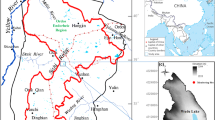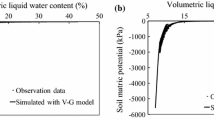Abstract
Because arid and semi-arid regions have relatively low soil moisture, water vapor movement often occurs predominantly in the unsaturated zone, affecting the partitioning of energy among various land surface fluxes. To understand the hydrological processes of the unsaturated zone in desert areas, it is important to characterize the diurnal and spatial variations in soil water and vapor movement, which control recharge and discharge via the unsaturated zone. However, few studies have examined the pattern of soil water and vapor movement affected by rainfall in desert areas. To understand this process, field observations of desert soil physical parameters and micrometeorological variables were taken. These data were used to verify and calibrate the performance of an unsaturated–saturated zone soil water balance model, Hydrus-1D. Next, the diurnal pattern of the soil water and vapor was simulated under different climatic conditions, i.e., before, during and after rainfall. Two stages of thermal liquid and vapor movement were identified before rainfall. The thermal liquid flux fluctuates quickly and drastically, while the thermal vapor changes more moderately during and after rainfall. The changes in isothermal liquid and vapor flux differ from those of thermal liquid and vapor flux because of the change in the pressure head gradient under various wetness conditions. These findings offer insight into how water vapor affects soil water movement in the semiarid desert. They also improve our understanding of the liquid water and water vapor movement processes following rainfall.














Similar content being viewed by others
References
Banimahd SA, Zand-Parsa S (2013) Simulation of evaporation, coupled liquid water, water vapor and heat transport through the soil medium. Agr Water Manage 130:168–177
Cass A, Campbell GS, Jones TL (1984) Enhancement of thermal water vapor diffusion in soil. Soil Sci Soc Am J 48:25–32
Chung SO, Horton R (1987) Soil heat and water flow with a partial surface mulch. Water Resour Res 23:2175–2186
de Marsily G (1986) Quantitative hydrogeology. Academic Press, London
Deb SK, Shukla MK, Sharma P, Mexal JD (2011) Coupled liquid water, water vapor, and heat transport simulations in an unsaturated zone of a sandy loam field. Soil Sci 176:387–398
Fayer MJ (2000) UNSAT-H Version 3.0: unsaturated soil water and heat flow model-theofy, user manual and examples, Pacific Northwest National Laboratory, Washingto, p 331
Garcia CA, Andraski BJ, Stonestrom DA, Cooper CA, Simunek J, Wheatcraft SW (2011) Interacting vegetative and thermal contributions to water movement in desert soil. Vadose Zone J 10:552–564
Gurr CG, Marshall TJ, Hutton JT (1952) Movement of water in soil due to a temperature gradient. Soil Sci 74:335–345
Huang JT, Zhou YX, Yin LH, Wenninger J, Zhang J, Hou GC, Zhang EY, Uhlenbrook S (2015) Climatic controls on sap flow dynamics and used water sources of Salix psammophila in a semi-arid environment in northwest China. Environ Earth Sci 73:289–301
Li X, Zhang Z, Huang L, Wang X (2013) Review of the ecohydrological processes and feedback mechanisms controlling sand-binding vegetation systems in sandy desert regions of china. Chinese Sci Bull 58:1483–1496
Martinez JJ, Skaggs TH, van Genuchten MT, Candela L (2009) A root zone modeling approach to estimating groundwater recharge from irrigated areas. J Hydrol 367:138–149
Nassar IN, Horton R (1989) Water transport in unsaturated nonisothermal salty soil: II. Theoretical development. Soil Sci Soc Am J 53:1330–1337
Nassar IN, Horton R (1992) Simultaneous transfer of heat, water, and solute in porous media: I. Theoretical development. Soil Sci Soc Am J 56:1350–1356
Nassar IN, Horton R (1997) Heat, water, and solution transfer in unsaturated porous media: I—theory development and transport coefficient evaluation. Transp Porous Med 27:17–38
Noborio K, McInnes KJ, Heilman JL (1996) Two-dimensional model for water, heat, and solute transport in furrow-irrigated soil: I. Field evaluation. Soil Sci Soc Am J 60(4):1010–1021
Oosterbaan RJ, Nijland HJ (1994) Determing the saturated hydraulic conductivity. In H.P. Titzema, ed. Drainage principles and applications, pp 435–475. 2nd edition. ILRI Publication 16. Wageningen, The Netherlands, ILRI
Penman HL (1940) Gas and vapor movements in soil: the diffusion of vapors through porous solids. J Agr Sci 30:437–462
Philip JR, de Vries DA (1957) Moisture movement in porous materials under temperature gradients. Trans Am Geophys Union 38:222–232
Saito H, Šimůnek J (2009) Effect of meteorological models on the solutions of the surface energy balance and soil temperature variations in bare soils. J Hydrol 373:545–561
Saito H, simunek J, Mohanty BP (2006) Numerical analysis of coupled water, vapor, and heat transport in the vadose zone. Vadose Zone J 5(2):784–800
Schaap MG, Leij FJ, van Genuchten MTh (2001) Rosetta: a computer program for estimating soil hydraulic parameters with hierarchical pedotransfer functions. J Hydrol 251:163–176
Schwinning S, Sala OE (2004) Hierarchy of responses to resource pulses in arid and semi-arid ecosystems. Oecol 141:211–220
Šimůnek J, Šejna M, Saito H, Sakai M, van Genuchten M Th (2012) The Hydrus-1D software package for simulating the one-dimensional movement of water, heat, and multiple solutes in variably-saturated media. Version 4.15. Department of environmental sciences university of California riverside riverside, California
Smits KM, Cihan A, Sakaki T, Illangasekare TH (2011) Evaporation from soils under thermal boundary conditions: experimental and modeling investigation to compare equilibrium- and nonequilibrium-based approaches. Water Resour Res 47(5):143–158
van Genuchten MTh (1980) A closed-form equation for predicting the hydraulic conductivity of unsaturated soils. Soil Sci Soc Am J 44:892–898
Webb SW, Ho CK (1998) Review of enhanced vapor diffusion in porous media, SAND-98-1819C; CONF-980559
Yang Z, Zhou YX, Wenninger J, Uhlenbrook S (2012) The causes of flow regime shifts in the semi-arid Hailiutu River, Northwest China. Hydrol Earth Syst Sc16:87–103
Yin J, Young MH, Yu Z (2008) Effects of paleoclimate and time-varying canopy structures on paleowater fluxes. J Geophys Res 113:304–312
Zeng YJ, Wan L, Su ZB, Saito H, Huang KL, Wang XS (2009) Diurnal soil water dynamics in the shallow vadose zone (field site of China University of Geosciences, China). Environ Geol 58:11–23
Zeng YZ, Su ZB, Wan L, Wen J (2011) A simulation analysis of the advective effect on evaporation using a two-phase heat and mass flow model. Water Resour Res 47(10):582
Zhao W, Liu B (2010) The response of sap flow in shrubs to rainfall pulses in the desert region of china. Agr Forest Meteorol 150:1297–1306
Acknowledgments
This study was supported by the National Natural Science Foundation of China (41102160; 41472220), the Ministry of Land and Resources of the People’s Republic of China (201311076), the Fundamental Research Funds for the Central Universities (2013G1502030) and the Natural Science Foundation of Shaanxi Province (2014JQ5187; 2015KJXX-69). The authors are grateful to the reviewers; the comments and suggestions of the reviewers have contributed significantly to the improvement of the manuscript.
Author information
Authors and Affiliations
Corresponding author
Rights and permissions
About this article
Cite this article
Huang, J., Hou, R. & Yang, H. Diurnal pattern of liquid water and water vapor movement affected by rainfall in a desert soil with a high water table. Environ Earth Sci 75, 73 (2016). https://doi.org/10.1007/s12665-015-4938-x
Received:
Accepted:
Published:
DOI: https://doi.org/10.1007/s12665-015-4938-x




